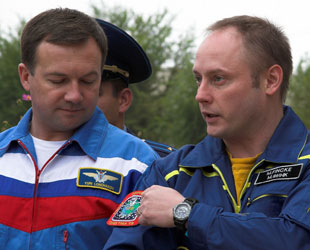October 10, 2008 — As the commander of the next flight to the International Space Station, Yuri Lonchakov was in charge of designing a patch to represent his three-person crew. In some ways, his job was made easy. With a long history of flights and mission patches — including two that incorporated his name — Lonchakov knew what elements he needed to include.
"I will have [on] my patch maybe Earth and three people in spacesuit who grab the Earth and [at the bottom of the patch] will be 'TMA-13'," he described to collectSPACE in July, noting the inclusion of his mission's designation. He also planned to include his and his crewmembers' names, Michael Fincke and Richard Garriott.
At the center of the capsule-shaped insignia would be the number 100.
"And this will be 100[th] flight in Soyuz with people," said Lonchakov.
Two months later in mid-September, Lonchakov and his crew mates received the first prototypes of their patches exactly as Lonchakov had described. The 100th crew to ride a Russian Soyuz would dress the part; their patches boldly exhibiting the milestone their mission would fulfill.
Or would it?

Soyuz TMA-13 crew member Mike Fincke points to his patch as its designer, commander Yuri Lonchakov looks on. (NASA) |
Less than a week before Soyuz TMA-13 was scheduled to launch, Russia's Federal Space Agency Roscosmos published an article on its website, which when translated to English was essentially titled, "On what basis is the Soyuz TMA-13 mission the 100th?". Written by Alexander Zheleznyakov, one of Russia's leading space experts and a member of the Russian Academy of Space Exploration, the article seemed to call into question the central theme of Lonchakov's design, literally.
"Such a calculation is a 'drag for the ears' and has never been used," wrote Zheleznyakov of how the total of 100 was reached, adding, "I do not recommend it," as it'll take a long time to explain.
Briefly then, what Zheleznyakov outlines is the difference between Soyuz spacecraft that carried people and those that launched and reached orbit with cosmonauts aboard since the first Soyuz mission in 1967: a difference of just three flights.
Two of the Soyuz at issue both had crews on-board, but had to abort before they could achieve orbit. Taking place in 1975 and 1983 respectively, the two would-be space missions weren't even given proper designations. Since the start of the space age, the then Soviet Union made it a point not to name their missions until they were safely in space, so even then Soyuz 18-1 and Soyuz T-10-1, as they are now recorded, didn't count.
At least Soyuz 18-1 (also referred to as Soyuz 18a) made it to space. At 90 miles altitude, a stage separation failure forced the Soyuz to automatically rocket from its booster, saving the lives of Vasili Lazarev and Oleg Makarov, who then flew a suborbital trajectory back to the ground.
Soyuz T-10-1 (Soyuz T-10a) didn't even leave the launch pad, or rather, its rocket didn't. The Soyuz, with Vladimir Titov and Gennady Strekalov inside, was pulled to safety two seconds before the booster exploded due to a fire on the pad. The launch escape system's thrusters lifted the Soyuz just over 2,000 feet into the air before the vehicle plunged back to the earth under an emergency parachute.
And then there's Soyuz 34, which orbited successfully in 1979, but was launched without a crew. Docking with the Salyut 6 space station, it returned to Earth with Vladimir Lyakhov and Valery Ryumin, who in turn had launched on Soyuz 32. The latter spacecraft returned to Earth empty.
Thus, Zheleznyakov argues, Soyuz TMA-13 will only be the 97th manned Soyuz to launch, or 99th if you consider the two aborts to be missions. To reach 100, you would need to ignore launches altogether and count spacecraft that at any point during its flight had cosmonauts aboard.
Ultimately, he writes, "the figure is not correct."
Correct or not, barring a last minute change of patch, the crew of Soyuz TMA-13 will launch on Sunday, October 12 with a '100' on their spacesuits.
